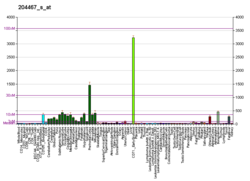
Back ألفا-ساينوكلين Arabic Alfa-sinucleïna Catalan Α-Synuclein German Alfa-sinucleína Spanish آلفا-سینوکلئین Persian Alpha-synucléine French Alfa-sinucleína Galician אלפא-סינוקלאין HE Alfa-sinucleina Italian Α-シヌクレイン Japanese
Alpha-synuclein (aSyn) is a protein that, in humans, is encoded by the SNCA gene.[5] Alpha-synuclein is a neuronal protein that regulates synaptic vesicle trafficking and subsequent neurotransmitter release.[6][7]
It is abundant in the brain, while smaller amounts are found in the heart, muscle and other tissues. In the brain, alpha-synuclein is found mainly in the axon terminals of presynaptic neurons.[5] Within these terminals, alpha-synuclein interacts with phospholipids[8] and proteins.[5][9][10] Presynaptic terminals release chemical messengers, called neurotransmitters, from compartments known as synaptic vesicles. The release of neurotransmitters relays signals between neurons and is critical for normal brain function.[5]
In Parkinson's disease and other synucleinopathies, insoluble forms of alpha-synuclein accumulate as inclusions in Lewy bodies.[11]
Familial Parkinson's disease is associated with mutations in the -synuclein (SNCA) gene. In the process of seeded nucleation, alpha-synuclein acquires a cross-sheet structure similar to other amyloids.[12]
The human alpha-synuclein protein is made of 140 amino acids.[13][14][15] An alpha-synuclein fragment, known as the non-amyloid beta (non-Abeta) component (NAC) of Alzheimer's disease amyloid, originally found in an amyloid-enriched fraction, was shown to be a fragment of its precursor protein, NACP.[13] It was later determined that NACP is the human homologue of synuclein in electric rays, genus Torpedo. Therefore, NACP is now referred to as human alpha-synuclein.[16]
- ^ a b c GRCh38: Ensembl release 89: ENSG00000145335 – Ensembl, May 2017
- ^ a b c GRCm38: Ensembl release 89: ENSMUSG00000025889 – Ensembl, May 2017
- ^ "Human PubMed Reference:". National Center for Biotechnology Information, U.S. National Library of Medicine.
- ^ "Mouse PubMed Reference:". National Center for Biotechnology Information, U.S. National Library of Medicine.
- ^ a b c d "Genetics Home Reference: SNCA". U.S. National Library of Medicine. 12 Nov 2013. Retrieved 14 Nov 2013.
- ^ Bonini NM, Giasson BI (November 2005). "Snaring the function of alpha-synuclein". Cell. 123 (3): 359–361. doi:10.1016/j.cell.2005.10.017. PMID 16269324. S2CID 18772904.
- ^ Chandra S, Gallardo G, Fernández-Chacón R, Schlüter OM, Südhof TC (November 2005). "Alpha-synuclein cooperates with CSPalpha in preventing neurodegeneration". Cell. 123 (3): 383–396. doi:10.1016/j.cell.2005.09.028. PMID 16269331. S2CID 18173864.
- ^ Chandra S, Chen X, Rizo J, Jahn R, Südhof TC (April 2003). "A broken alpha -helix in folded alpha -Synuclein". The Journal of Biological Chemistry. 278 (17): 15313–15318. doi:10.1074/jbc.M213128200. PMID 12586824. S2CID 27116894.
- ^ Cite error: The named reference
:0was invoked but never defined (see the help page). - ^ Atias M, Tevet Y, Sun J, Stavsky A, Tal S, Kahn J, et al. (June 2019). "Synapsins regulate α-synuclein functions". Proceedings of the National Academy of Sciences of the United States of America. 116 (23): 11116–11118. Bibcode:2019PNAS..11611116A. doi:10.1073/pnas.1903054116. PMC 6561288. PMID 31110014.
- ^ Spillantini MG, Schmidt ML, Lee VM, Trojanowkski JQ, Jakes R, Goedert M (28 August 1997). "α-Synuclein in Lewy bodies". Nature. 388 (6645): 839–840. Bibcode:1997Natur.388..839G. doi:10.1038/42166. PMID 9278044. S2CID 4419837.
- ^ Zigmond MJ, Coyle JT, Rowland JP (2015). Neurobiology of brain disorders : biological basis of neurological and psychiatric disorders. London. ISBN 978-0-12-398280-3. OCLC 896232309.
{{cite book}}: CS1 maint: location missing publisher (link) - ^ a b Uéda K, Fukushima H, Masliah E, Xia Y, Iwai A, Yoshimoto M, et al. (December 1993). "Molecular cloning of cDNA encoding an unrecognized component of amyloid in Alzheimer disease". Proceedings of the National Academy of Sciences of the United States of America. 90 (23): 11282–11286. Bibcode:1993PNAS...9011282U. doi:10.1073/pnas.90.23.11282. PMC 47966. PMID 8248242.
- ^ Xia Y, Saitoh T, Uéda K, Tanaka S, Chen X, Hashimoto M, et al. (October 2001). "Characterization of the human alpha-synuclein gene: Genomic structure, transcription start site, promoter region and polymorphisms". Journal of Alzheimer's Disease. 3 (5): 485–494. doi:10.3233/JAD-2001-3508. PMID 12214035. Archived from the original on 2016-05-14. Retrieved 2009-02-19.
- ^ Xia Y, Saitoh T, Uéda K, Tanaka S, Chen X, Hashimoto M, Hsu L, Conrad C, Sundsmo M, Yoshimoto M, Thal L, Katzman R, Masliah E (2002). "Characterization of the human alpha-synuclein gene: Genomic structure, transcription start site, promoter region and polymorphisms: Erratum p489 Fig 3". J. Alzheimers Dis. 4 (4): 337. Archived from the original on 2016-05-14. Retrieved 2009-02-19.
- ^ Jakes R, Spillantini MG, Goedert M (May 1994). "Identification of two distinct synucleins from human brain". FEBS Letters. 345 (1): 27–32. doi:10.1016/0014-5793(94)00395-5. PMID 8194594. S2CID 36840279.
© MMXXIII Rich X Search. We shall prevail. All rights reserved. Rich X Search






